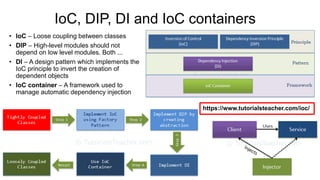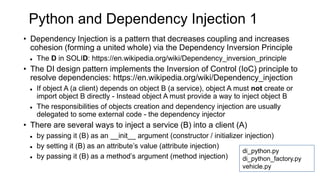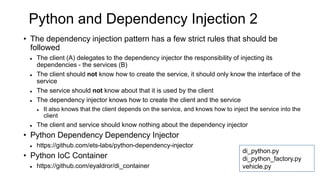Mock objects are simulated objects used in unit testing to isolate and test specific parts of code without dependencies on other objects. The unittest.mock library provides a Mock class that can be used to create mock objects. Mock objects are flexible and create attributes on demand to mimic real objects. They record how they are used to make assertions. Common uses of mock objects include setting return values, configuring side effects like exceptions, and attaching mocks as child objects.

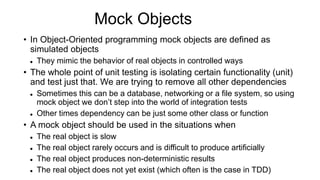


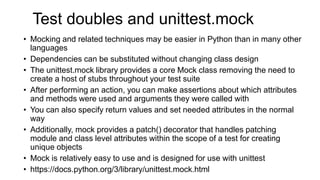
![unittest.mock Quick Guide – return_value and side_effect
from unittest.mock import Mock # import the Mock class
from unittest.mock import MagicMock # import the MagicMock class
class ProductionClass():
def __init__(self):
pass
# Mock and MagicMock objects create all attributes and methods as you access them and store details
# of how they have been used. You can configure them, to specify return values or limit what
# attributes are available, and then make assertions about how they have been used
thing = ProductionClass()
thing.method = MagicMock(return_value = 3) # calling method() will return 3
print(thing.method()) # print the return_value
thing.method(3, 4, 5, key = 'value')
thing.method.assert_called_with(3, 4, 5, key ='value') # AssertionError if different than expected call
print(dir(Mock())) # show all the default mock methods / attributes
# side_effect allows you to perform side effects, including raising an exception when a mock is called
my_mock = Mock(side_effect = KeyError('foo')) # create a new mock object with KeyError exception
# my_mock() # mock -> side_effect = KeyError exception
values = {'a': 1, 'b': 2, 'c': 3}
def side_effect_func(arg):
return values[arg]
my_mock.side_effect = side_effect_func # mock -> side_effect_func
print(my_mock('a'), my_mock('b'), my_mock('c')) # print values side_effect_func(arg)
my_mock.side_effect = [5, 4, 3, 2, 1] # change side_effect again
for x in range(0, 5): # side_effect now returns array one by one
print(my_mock())
quick_guide_mock1.py # output
thing.method(): 3
dir(Mock()):
['assert_any_call',
'assert_called',
'assert_called_once',
'assert_called_once_with',
'assert_called_with',
'assert_has_calls',
'assert_not_called',
'attach_mock', 'call_args',
'call_args_list', 'call_count',
'called', 'configure_mock',
'method_calls', 'mock_add_spec',
'mock_calls', 'reset_mock',
'return_value', 'side_effect']
dict:
1 2 3
range:
5
4
3
2
1](https://image.slidesharecdn.com/mt04mockingpython-230220090704-59e99676/85/Python-mocking-intro-6-320.jpg)

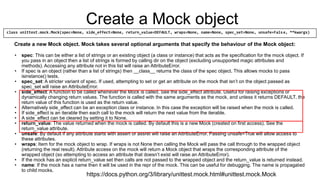

![Mock class attributes 2
• __dir__()
Mock objects limit the results of dir(some_mock) to useful results
• _get_child_mock(**kw)
Create the child mocks for attributes and return value
• called
A boolean representing whether or not the mock object has been called
• call_count
An integer telling you how many times the mock object has been called
• return_value
Set this to configure the value returned by calling the mock
• side_effect
This can either be a function to be called when the mock is called, an iterable or an exception (class or instance)
to be raised
• call_args
This is either None (if the mock hasn’t been called), or the arguments that the mock was last called with
• call_args_list
This is a list of all the calls made to the mock object in sequence
• method_calls
As well as tracking calls to themselves, mocks also track calls to methods and attributes, and their methods and
attributes
• mock_calls
mock_calls records all calls to the mock object, its methods, magic methods and return value mocks
• __class__
Normally the __class__ attribute of an object will return its type. For a mock object with a spec, __class__ returns
the spec class instead
# examples
mock_obj.return_value = 10
mock_obj.side_effect = [1, 2, 3]](https://image.slidesharecdn.com/mt04mockingpython-230220090704-59e99676/85/Python-mocking-intro-10-320.jpg)
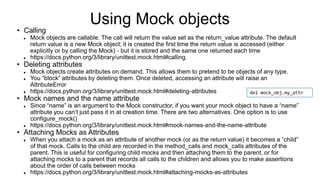


![Basic concepts unittest.mock – side_effect 2
# The last and perhaps most used case is that of passing a callable to side_effect, which shamelessly executes it with
# its own same parameters. This is very powerful, especially if you stop thinking about "functions" and start considering
# "callables". Indeed, side_effect also accepts a class and calls it, that is it can instantiate objects. Let us consider
# a simple example with a function without arguments
m1.some_attribute.side_effect = print_answer
m1.some_attribute()
# A slightly more complex example: a function with arguments
m1.some_attribute.side_effect = print_number
m1.some_attribute.side_effect(5)
# And finally an example with a class
m1.some_attribute.side_effect = Number
n1 = m1.some_attribute.side_effect(26)
n1.print_value()
# All the default mock methods / attributes
# ['assert_any_call', 'assert_called', 'assert_called_once', 'assert_called_once_with', 'assert_called_with',
# 'assert_has_calls', 'assert_not_called', 'attach_mock', 'call_args', 'call_args_list', 'call_count', 'called',
# 'configure_mock', 'method_calls', 'mock_add_spec', 'mock_calls', 'reset_mock', 'return_value', 'side_effect']
# From: http://www.thedigitalcatonline.com/blog/2016/03/06/python-mocks-a-gentle-introduction-part-1/
class Number(object):
def __init__(self, value):
self._value = value
def print_value(self):
print("Value:", self._value)
def print_answer():
print("42")
def print_number(num):
print(f"Number: {num}")
gentle_intro_to_mock1.py](https://image.slidesharecdn.com/mt04mockingpython-230220090704-59e99676/85/Python-mocking-intro-14-320.jpg)

![unittest.mock Mock class
• We check that the Hello.bar() method is called correct with ’HELLO’
• camelCase setUp() and tearDown() can perform initialization and cleanup of the test
fixture since they are called before and after the test
import unittest
from unittest.mock import Mock
class HelloTestTest(unittest.TestCase):
def setUp(self):
self.hello = Hello()
def tearDown(self):
pass
def test_foo(self):
msg = 'hello'
expected_bar_arg = 'HELLO'
self.hello.bar = Mock() # we mock the bar() method
self.hello.foo(msg)
# we check that bar was called with 'HELLO'
self.hello.bar.assert_called_once_with(expected_bar_arg)
if __name__ == '__main__':
unittest.main(argv=['first-arg-is-ignored'], exit=False)
class Hello(object):
def foo(self, msg):
MSG = msg.upper()
self.bar(MSG)
# the mocked bar() method
# def bar(self, MSG):
# print(MSG)
test_hellomock.py](https://image.slidesharecdn.com/mt04mockingpython-230220090704-59e99676/85/Python-mocking-intro-16-320.jpg)
![unittest.mock MagicMock class
• MagicMock is a subclass of Mock with default implementations of most of the magic methods
• You can use MagicMock without having to configure the magic methods yourself
import unittest
from unittest.mock import MagicMock
from employee import Employee
class TestMocking(unittest.TestCase):
def test_mock1(self):
thing = Employee('Hans', 'Jones', 50)
# set return value
thing.method = MagicMock(return_value = 3)
# call the method
ret = thing.method(3, 4, 5, key='value')
print(f'ret: {ret}')
# check if we called correct
thing.method.assert_called_with(3, 4, 5, key='value')
if __name__ == '__main__':
unittest.main(argv=['first-arg-is-ignored'], exit=False)
test_mock.py
class Employee:
"""A sample Employee class"""
raise_amt = 1.05
def __init__(self, first, last, pay):
self.first = first
self.last = last
self.pay = pay](https://image.slidesharecdn.com/mt04mockingpython-230220090704-59e99676/85/Python-mocking-intro-17-320.jpg)


![unittest.mock patch() function
• patch() is the main mocking mechanism for the unittest.mock library
• patch() works by (temporarily) changing the object that a name points to with another one
• The basic principle is that you patch where an object is looked up, which is not necessarily the
same place as where it is defined
class TestMocking(unittest.TestCase):
# mocking MyMockedClass
def test_mock2(self):
# Patching a class replaces the class with a MagicMock instance
with patch('__main__.MyMockedClass') as MockClass:
# return_value of the mock will be used
instance = MockClass.return_value
instance.method.return_value = 'foo'
# assert MyMockedClass() is instance of MyMockedClass
self.assertIsInstance(instance, type(MyMockedClass()))
self.assertEqual(MyMockedClass().method(), 'foo')
self.assertEqual(instance.method(), 'foo')
if __name__ == '__main__':
unittest.main(argv=['first-arg-is-ignored'], exit=False)
import unittest
from unittest.mock import patch
class MyMockedClass:
def method(self):
pass
test_mock.py](https://image.slidesharecdn.com/mt04mockingpython-230220090704-59e99676/85/Python-mocking-intro-20-320.jpg)

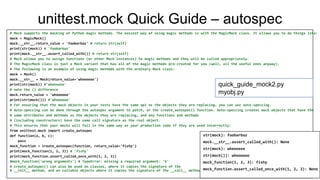
![patch() and new_callable
• patch() away sys.std - we replace an object (sys.stdout) with an io.StringIO instance with the @patch
decorator
• patch(target, new=DEFAULT, spec=None, create=False, spec_set=None, autospec=None,
new_callable=None, **kwargs)
from io import StringIO
import unittest
from unittest.mock import patch
class MyMockedClass:
def foo_print(self):
print('Something that is not going to be printed to sys.stdout')
class TestMocking(unittest.TestCase):
@patch('sys.stdout', new_callable=StringIO)
def test_mock3(self, mock_stdout):
thing = MyMockedClass()
thing.foo_print()
# assert mock_stdout.getvalue() == 'Somethingn' # sys.stdout.getvalue()
self.assertEqual(mock_stdout.getvalue(), 'Something that is not going to be printed to sys.stdoutn')
if __name__ == '__main__':
unittest.main(argv=['first-arg-is-ignored'], exit=False)
test_mock.py](https://image.slidesharecdn.com/mt04mockingpython-230220090704-59e99676/85/Python-mocking-intro-23-320.jpg)
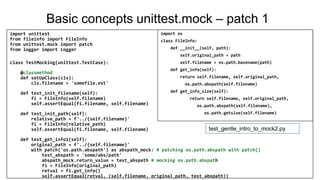
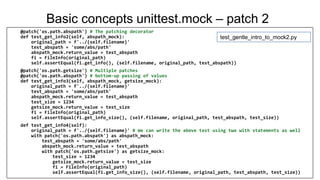
![Basic concepts unittest.mock – patch 3
# Patching immutable objects == no change after creation
def test_init_logger(self):
lg = Logger()
self.assertEqual(lg.messages, [])
# @patch('datetime.datetime.now')
# def test_log1(self, mock_now):
# test_now = 123
# test_message = "A test message"
# mock_now.return_value = test_now
# lg = Logger()
# lg.log(test_message)
# self.assertEqual(lg.messages, [(test_now, test_message)])
@patch('logger.datetime.datetime')
def test_log2(self, mock_datetime):
test_now = 123
test_message = "A test message"
mock_datetime.now.return_value = test_now
lg = Logger()
lg.log(test_message)
self.assertEqual(lg.messages, [(test_now, test_message)])
if __name__ == '__main__':
unittest.main(argv=['first-arg-is-ignored'], exit=False)
import datetime
class Logger:
def __init__(self):
self.messages = []
def log(self, message):
self.messages.append((datetime.datetime.now(),
message))
test_get_info1 (__main__.TestMocking) ... ok
test_get_info2 (__main__.TestMocking) ... ok
test_get_info3 (__main__.TestMocking) ... ok
test_get_info4 (__main__.TestMocking) ... ok
test_init_filename (__main__.TestMocking) ... ok
test_init_logger (__main__.TestMocking) ... ok
test_init_path (__main__.TestMocking) ... ok
test_log2 (__main__.TestMocking) ... ok
test_gentle_intro_to_mock2.py](https://image.slidesharecdn.com/mt04mockingpython-230220090704-59e99676/85/Python-mocking-intro-26-320.jpg)

![Python unittest.mock example
import unittest
from unittest.mock import patch
from employee import Employee
class TestEmployee(unittest.TestCase):
@classmethod
def setUpClass(cls):
print('setupClass')
@classmethod
def tearDownClass(cls):
print('teardownClass')
def setUp(self):
print('nsetUp')
self.emp_1 = Employee('Corey', 'Schafer', 50000)
self.emp_2 = Employee('Sue', 'Smith', 60000)
def tearDown(self):
print('tearDown')
#… additional code here removed for readability
def test_monthly_schedule(self):
with patch('employee.requests.get') as mocked_get:
mocked_get.return_value.ok = True
mocked_get.return_value.text = 'Success'
schedule = self.emp_1.monthly_schedule('May')
mocked_get.assert_called_with('http://company.com/Schafer/May')
self.assertEqual(schedule, 'Success')
mocked_get.return_value.ok = False
schedule = self.emp_2.monthly_schedule('June')
mocked_get.assert_called_with('http://company.com/Smith/June')
self.assertEqual(schedule, 'Bad Response!')
if __name__ == '__main__':
unittest.main(argv=['first-arg-is-ignored'], exit=False)
import requests
class Employee:
"""A sample Employee class"""
raise_amt = 1.05
def __init__(self, first, last, pay):
self.first = first
self.last = last
self.pay = pay
@property
def email(self):
return 'f{self.first}.{self.last}@email.com'
@property
def fullname(self):
return 'f{self.first} {self.last}'
def apply_raise(self):
self.pay = int(self.pay * self.raise_amt)
#… additional code here removed for readability
def monthly_schedule(self, month):
response = requests.get(f'http://company.com/{self.last}/{month}')
if response.ok:
return response.text
else:
return 'Bad Response!'
----------- OUTPUT -----------
PS C:python_unittesting> python .test_employee.py -v
setupClass
test_apply_raise (__main__.TestEmployee) ...
setUp
test_apply_raise
tearDown
ok
test_email (__main__.TestEmployee) ...
setUp
test_email
tearDown
ok
test_fullname (__main__.TestEmployee) ...
setUp
test_fullname
tearDown
ok
test_monthly_schedule (__main__.TestEmployee) ...
setUp
tearDown
ok
teardownClass
------------------------------------------------------
Ran 4 tests in 0.007s
test_employee.py
and employee.py](https://image.slidesharecdn.com/mt04mockingpython-230220090704-59e99676/85/Python-mocking-intro-28-320.jpg)
